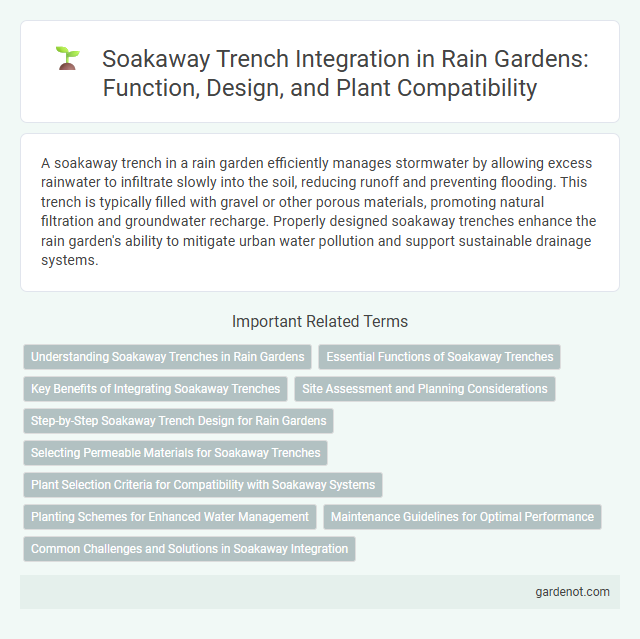A soakaway trench in a rain garden efficiently manages stormwater by allowing excess rainwater to infiltrate slowly into the soil, reducing runoff and preventing flooding. This trench is typically filled with gravel or other porous materials, promoting natural filtration and groundwater recharge. Properly designed soakaway trenches enhance the rain garden's ability to mitigate urban water pollution and support sustainable drainage systems.
Understanding Soakaway Trenches in Rain Gardens
Soakaway trenches in rain gardens efficiently manage stormwater by allowing water to infiltrate the soil, reducing surface runoff and preventing flooding. These trenches are typically filled with gravel or coarse materials to facilitate rapid drainage while filtering pollutants. Proper design and placement ensure enhanced groundwater recharge and protect local water quality by capturing and naturally treating rainwater.
Essential Functions of Soakaway Trenches
Soakaway trenches play a crucial role in managing stormwater by facilitating rapid infiltration and reducing surface runoff, thereby preventing flooding and erosion. These trenches enhance groundwater recharge by allowing collected rainwater to percolate through permeable layers, promoting soil moisture retention. By filtering pollutants during infiltration, soakaway trenches help improve water quality and support sustainable urban drainage systems.
Key Benefits of Integrating Soakaway Trenches
Soakaway trenches enhance rain garden performance by facilitating efficient stormwater infiltration, reducing surface runoff and mitigating flood risks. By promoting groundwater recharge, they improve local water tables and support sustainable urban drainage systems (SUDS). Their integration reduces soil erosion, filters pollutants, and supports biodiversity within the rain garden ecosystem.
Site Assessment and Planning Considerations
Site assessment for a soakaway trench involves evaluating soil permeability, groundwater levels, and slope to ensure effective water infiltration and prevent overflow. Planning considerations include locating the trench away from building foundations and utilities, sizing based on estimated runoff volume, and ensuring proper maintenance access. Incorporating native vegetation around the trench enhances filtration and supports local biodiversity.
Step-by-Step Soakaway Trench Design for Rain Gardens
Designing a soakaway trench for rain gardens involves excavating a narrow, linear pit filled with gravel or coarse stone to facilitate efficient stormwater infiltration. The trench dimensions should be calculated based on the catchment area, soil permeability, and expected rainfall volume, typically maintaining a length-to-width ratio of 3:1 for optimal drainage. Incorporating a geotextile fabric lining prevents soil clogging while maintaining permeability, ensuring long-term effectiveness in managing runoff through natural infiltration.
Selecting Permeable Materials for Soakaway Trenches
Choosing permeable materials for soakaway trenches significantly enhances water infiltration and reduces surface runoff in rain garden systems. Gravel, crushed stone, and coarse sand are optimal for their high porosity, allowing efficient drainage and preventing soil compaction. Incorporating geotextile fabric filters fine particles while maintaining permeability, ensuring long-term trench functionality.
Plant Selection Criteria for Compatibility with Soakaway Systems
Selecting plants for soakaway trenches requires species with high water tolerance and deep root systems to enhance soil permeability and prevent clogging. Native grasses, sedges, and moisture-loving perennials such as Carex, Juncus, and Iris versicolor thrive in these saturated conditions, promoting effective infiltration. Avoiding invasive or shallow-rooted plants ensures long-term stability and maximizes soakaway system performance.
Planting Schemes for Enhanced Water Management
Rain garden soakaway trenches benefit from planting schemes featuring native deep-rooted plants such as sedges, rushes, and ferns which enhance soil permeability and promote efficient water infiltration. Selecting a mix of herbaceous perennials and shrubs with varying root depths improves pollutant filtration and prevents soil erosion within the trench. Incorporation of drought-tolerant species like Carex or Juncus supports resilience to fluctuating water levels and optimizes long-term stormwater management.
Maintenance Guidelines for Optimal Performance
Regular inspection and removal of debris in soakaway trenches prevent clogging and maintain efficient water infiltration. Ensuring the trench remains free from soil compaction and sediment accumulation preserves its permeability and functionality. Periodic replacement of filter materials and monitoring vegetation health further optimize the trench's performance in rain garden systems.
Common Challenges and Solutions in Soakaway Integration
Soakaway trenches often face challenges such as soil compaction, poor drainage, and clogging due to sediment buildup, which reduce their efficiency in rain garden systems. Solutions include incorporating layered filtration materials like gravel and sand, installing geotextile membranes to prevent sediment infiltration, and ensuring regular maintenance to remove debris and maintain permeability. Proper site assessment to avoid high water table areas and designing with adequate sizing based on soil infiltration rates enhance soakaway performance and longevity.
Soakaway trench Infographic

 gardenot.com
gardenot.com